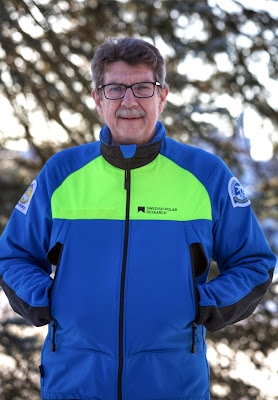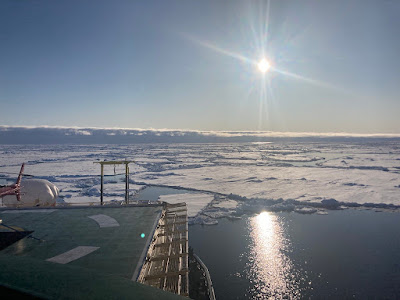Stationary in Svalbard before the departure today (Monday May 8) at midnight 23:59 towards the sea ice edge
Arrival in Svalbard on Sunday 7 May
After an early morning wake-up in the sunny but chilly Oslo, scientists and crew members headed towards the Oslo airport - with the destination Longyearbyen, Svalbard. There was many happy faces greeting each other at the gate - happy and excited for the coming 6 weeks in the Arctic. The journey to the north starts now!
 |
| Flying over the snow-covered mountains on Svalbard - almost there! |
The plane landed in Tromsö on the way to Longyearbyen. It was a beautiful weather flying above the Norwegian Sea over the clouds - until snow-covered mountains and glaciers were spotted from the heights - SVALBARD! Svalbard is an archipelago of mountains and fjords, just around 10 degrees south of the North Pole with over half of the archipelago covered by glaciers. The population of Svalbard is about 2.5 thousand - of which 25 % are students and living mainly in Longyearbyen. On Longyearbyen, which is the capital of Svalbard, there is actually a university called UNIS where lot of polar research and studies about polar meteorology are conducted. Even I had the pleasure to study half a semester here in this amazing environment in autumn 2016.
Most of us participants of the expedition met each other today for the first time - or it was a reunion with fellow colleagues. Some of us had brought their instruments as luggage with the plane, and fortunately all baggages as well as instrument boxes arrived safely to Longyearbyen. Once we arrived, many of us - happy of excitement and the stunning view - went out to look for Oden in the fjord - and there it was! Soon going to be the home for us all for the coming 6 weeks!
 |
| The icebreaker Oden located in the fjord outside Longyearbyen. |
We were picked up by bus from the airport to the harbour. As Oden was waiting for us in the fjord, we were then transported to Oden from the mainland by fast-driving rescue boats. The temperatures were slightly below zero and the sun was shining! The weather could not have been better to welcome us to Oden and as a start for the expedition.
 |
| The view from Oden while staying in the fjord. |
It felt amazing to step on Oden again - after two years. For many of us it was the n'th time on Oden (on on another Icebreaker, such as the German Icebreaker Polarstern), but for many of us it was the first time. I can still remember the excitement when stepping on an icebreaker and realising this will be our home for the next months! Upon arrival, we were checked-in and guided to our cabins.
Staying in the fjord until Monday May 8 23:59
Onboard we have many delicate instruments already installed on the ship, such as aerosol (small air-born particles) inlets on the roof of containers and energy and gas flux sensors attached to the 30m mast infront of the ship (se photo below). In close-zero temperatures with open sea, salty sea water when hitting on the instruments on Oden could do a lot of damage. Furthermore, as our plan is to head north where temperatures quickly drop way below freezing, the salty water that we might get onboard while moving would then freeze onto many of our instruments - and would not melt before we are back south in 6 weeks (as we head to the Arctic before the melt begins). Because of a storm out in the Greenland Sea, we decided to stay put in the fjord (where the weather conditions were calm) and wait for the storm to pass by. This was approximated to happen during Monday. Thus, instead of leaving Sunday evening as first planned, we stayed in Svalbard another day and are planning to depart today by midnight. For the target of our expedition - capturing these atmospheric rivers from the south - this was not a problem, as no atmospheric rivers were forecasted to happen within the coming few days. There might be a chance for southerly winds towards the end of the next week; however, as weather forecasts tend to become less reliable the longer in the forecast we go, we don't know this yet for certain.
 |
| Foremast in front of Oden with Eddy-covariance flux instruments measuring e.g., windspeed and turbulent fluxes. |
Even though first a bit sad not leaving towards the sea ice immediately in the evening, staying stationary with great weather also brings advantages. Many of us spent 3 days in April in Helsingborg on Oden to install instruments. However, this time was not enough for everyone and this extra day gave most of us more time to prepare their instruments for the expedition. For our Work-package (Arctic climate across scales / Boundary layer; where we have onboard instruments such as our weather station and lidars and the turbulence mast, on-ice work as well as launching weather balloons and operating drones), this day mostly included a quick but detailed go-through of the instruments we have onboard, check that they work and record if any issues have been observed. Scientists in Work-package 3 (measuring air-particles, i.e. aerosols) were working hard in their new-build container and making sure everything works - both instruments in the container as well as on the roof of their container.
 |
| Majority of the 10 scientists in the work-package 3 (aerosols and clouds) standing in our wool-sweaters on their container fixing the last instruments to be ready for the expedition. |
Apart from work preparations, these two days also included safety training - working on a ship has many dangerous things (machinery, wires hanging around, heavy equipments ...) and knowing how to work in a harsh, cold environment is imoportant. We got to try survival suites (if we need to leave the ship in emergency), learned about what to do in case of fire and what to do when we hear an alarm. Today, on Monday May 8, we also had several toolbox talks, where the safety and the procedures during e.g., working on ice or lab work, were discussed. Working with chemicals and other gases also require special attention. Working on deck when Oden is in the cold Arctic can cause slippery conditions and working on the ice on a living surface can also be dangerous - not to talk about polar bears. All of this was important and the topics were well discussed during the meetings.
 |
| Apart from the blue wools-weathers we were also given matching hats with the logo describing the goal of the expedition ARTofMELT. |
Heading in the night towards the sea ice edge
Preparations continue and discussions of what to do when we reach the sea ice edge after departure are heard all around the ship. Soon, in just a few minutes, we will leave the fjord and head north along the western coast of Svalbard. As we will operate on Oden in UTC time, we will switch 2 hours back at 2:00 in the night - so that we will experience midnight twice ;)
Leaving at midnight, the approximated time when the first ice floes will be floating by will be in early morning. The marginal ice zone (sea ice edge) is approximated to be reached at 14:00 UTC tomorrow (Tuesday 9 May). A quick transit as we are already located so much up north and this time of the year with an ice edge extending further south. The plan is to stay at the marginal ice zone for a couple of days, as some of us are happy to get extra measurements exactly at the ice edge. But as soon as there might be indicators of southerly warm airflows in the forecast, we might decide to move more north towards where the atmospheric river is expected to hit.
The journey to the Arctic begins now! From now on, we'll be without internet access on Oden as long as we are in the sea ice in the Arctic Ocean, until approximately 15th of June. Postings about how this expedition precedes with some photos from the Arctic and our research will come approximately every third day, depending on whenever the satellite connection allows for transmission and if the weather conditions do not keep us too busy.
Follow us into the cold Arctic with the Icebreaker Oden to capture the melt onset over Arctic sea ice - do we succeed?





Comments
Post a Comment